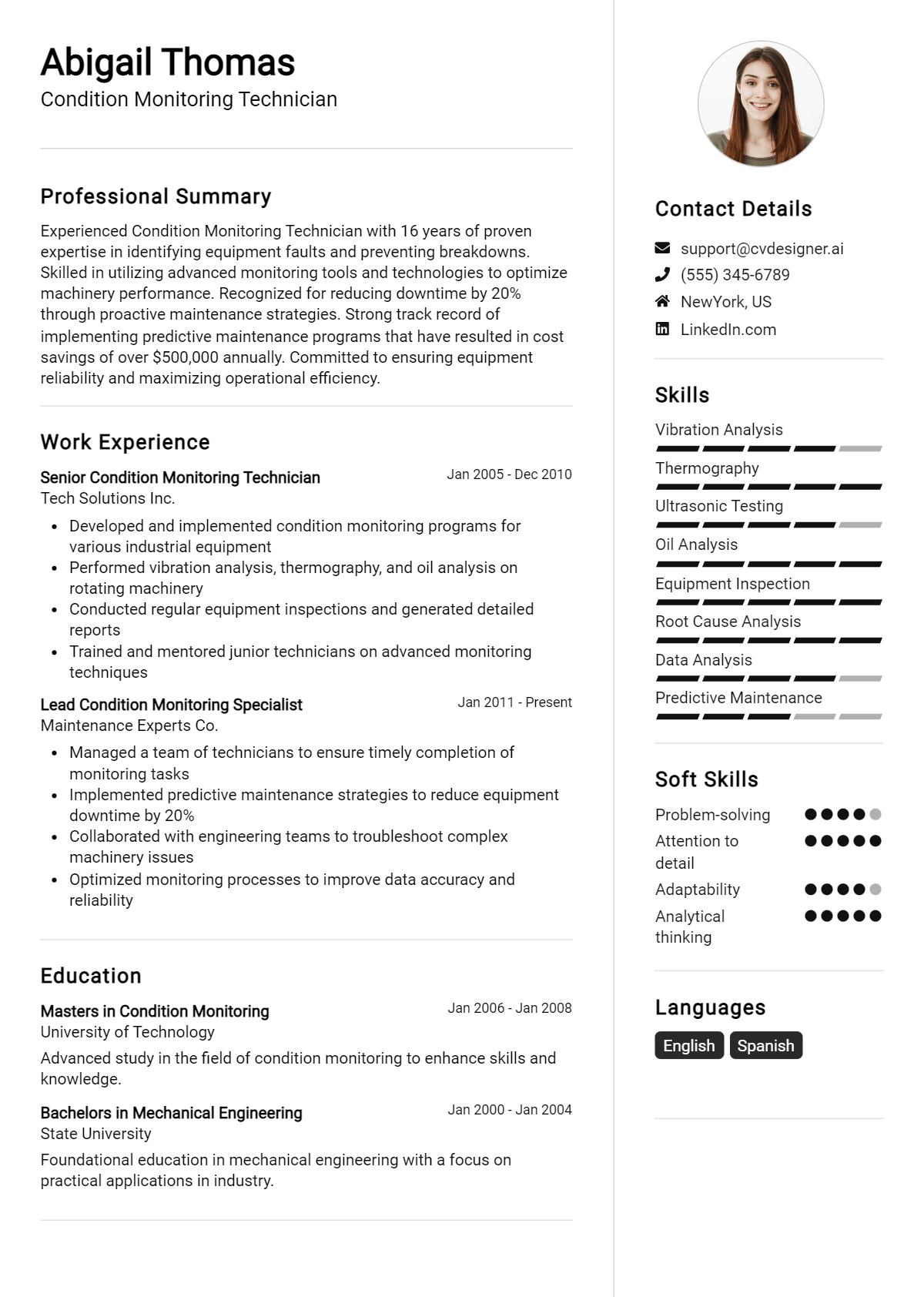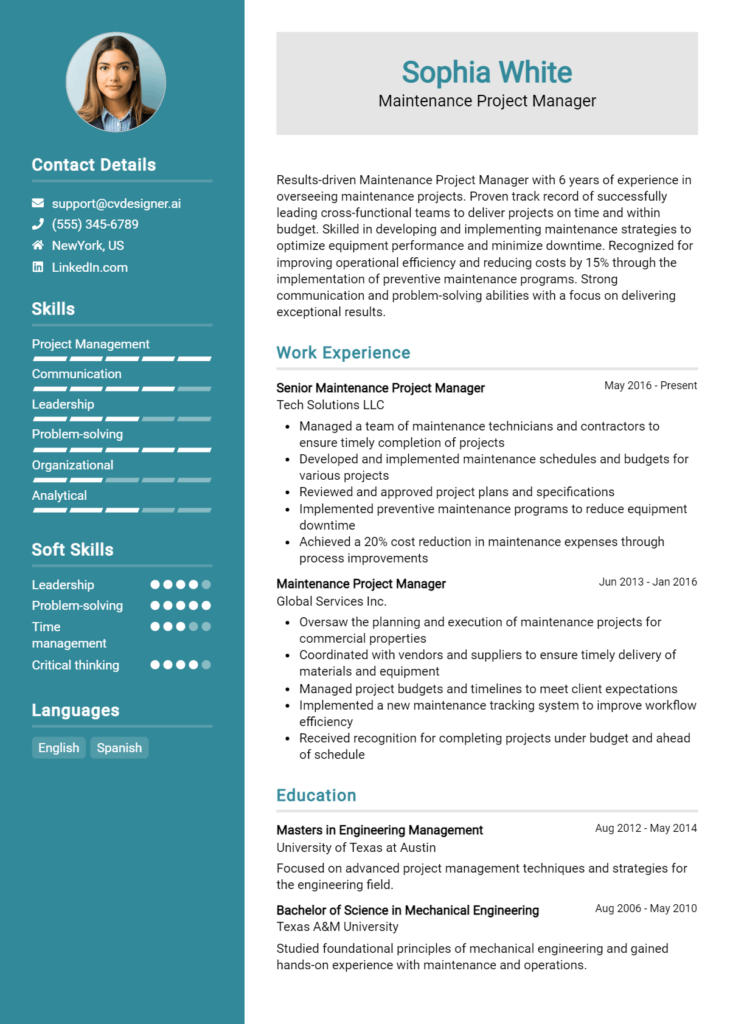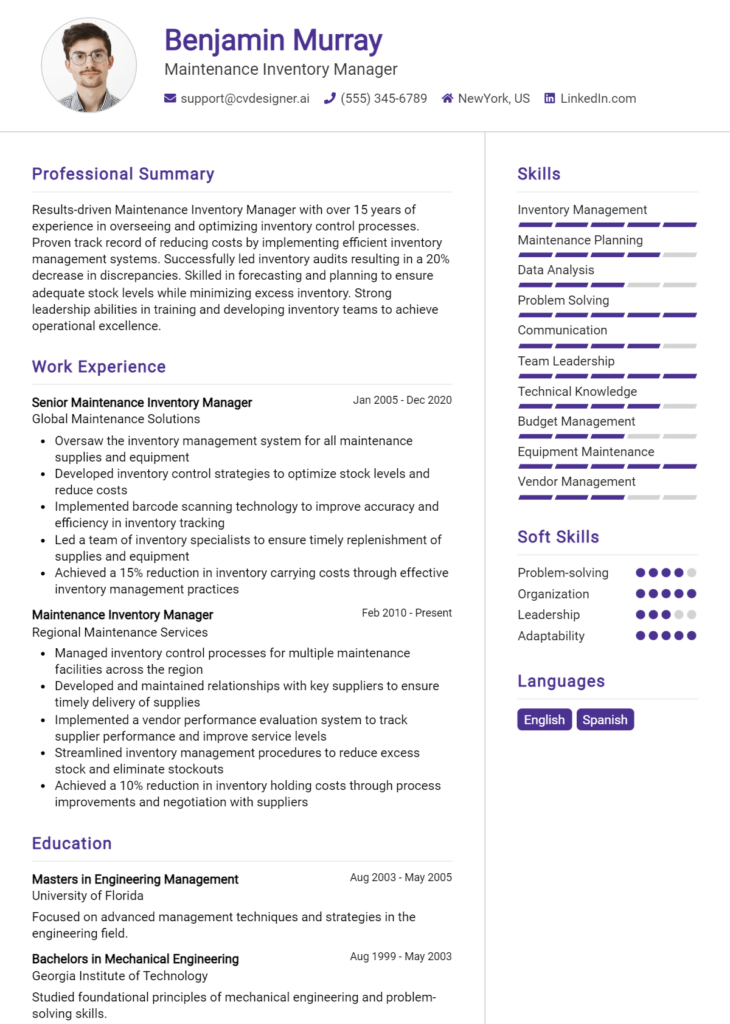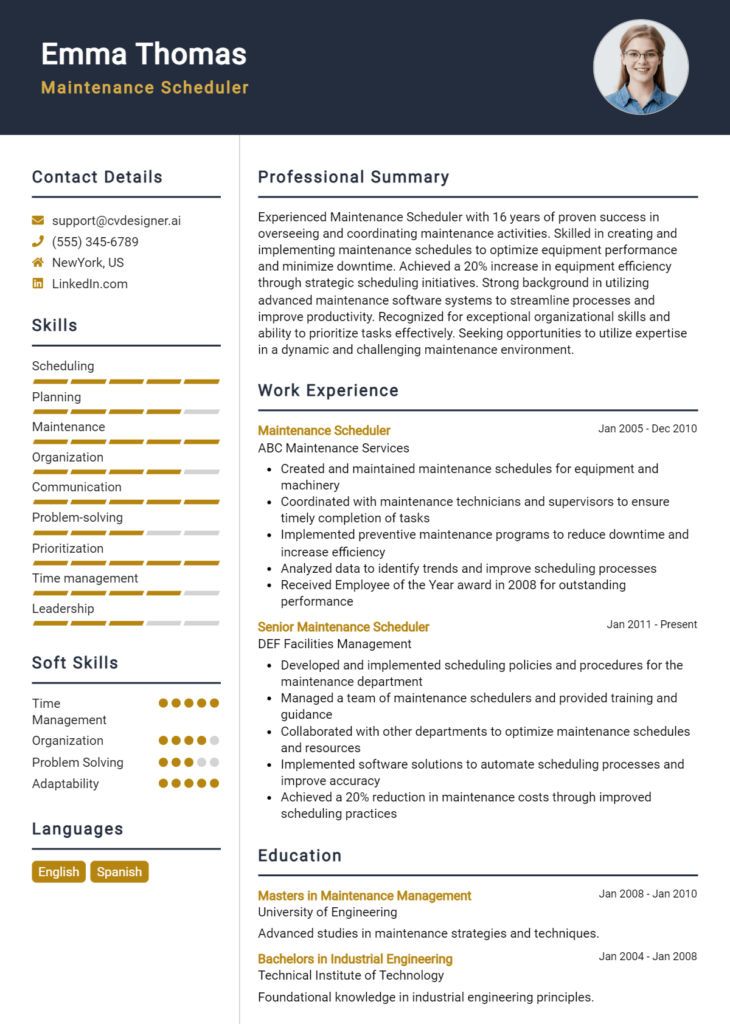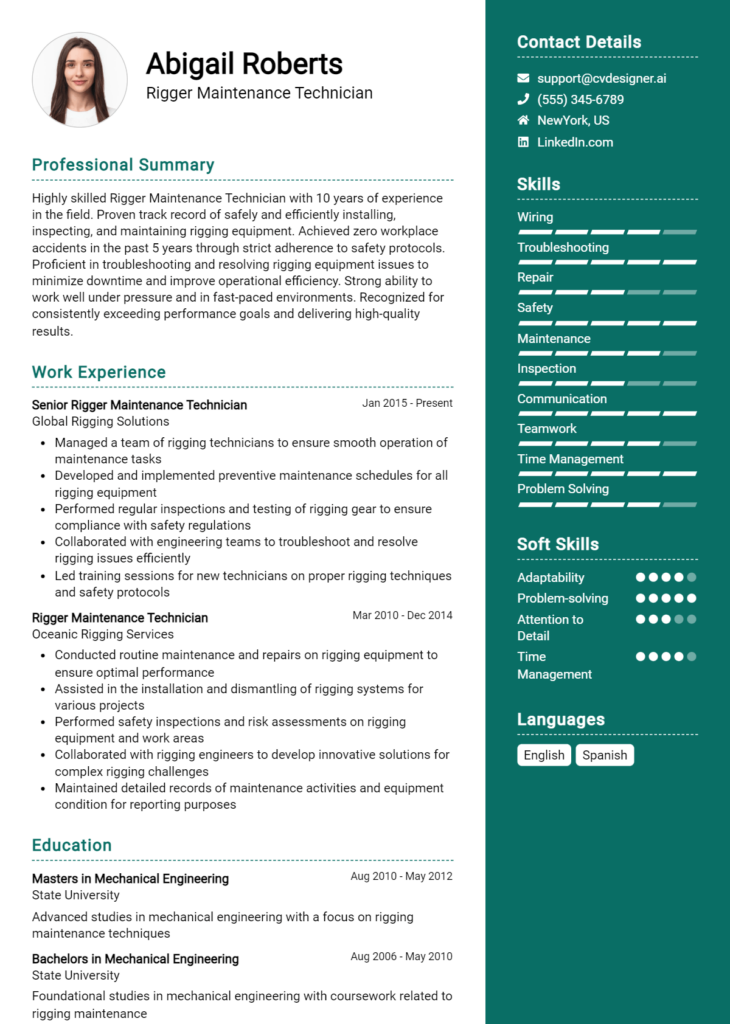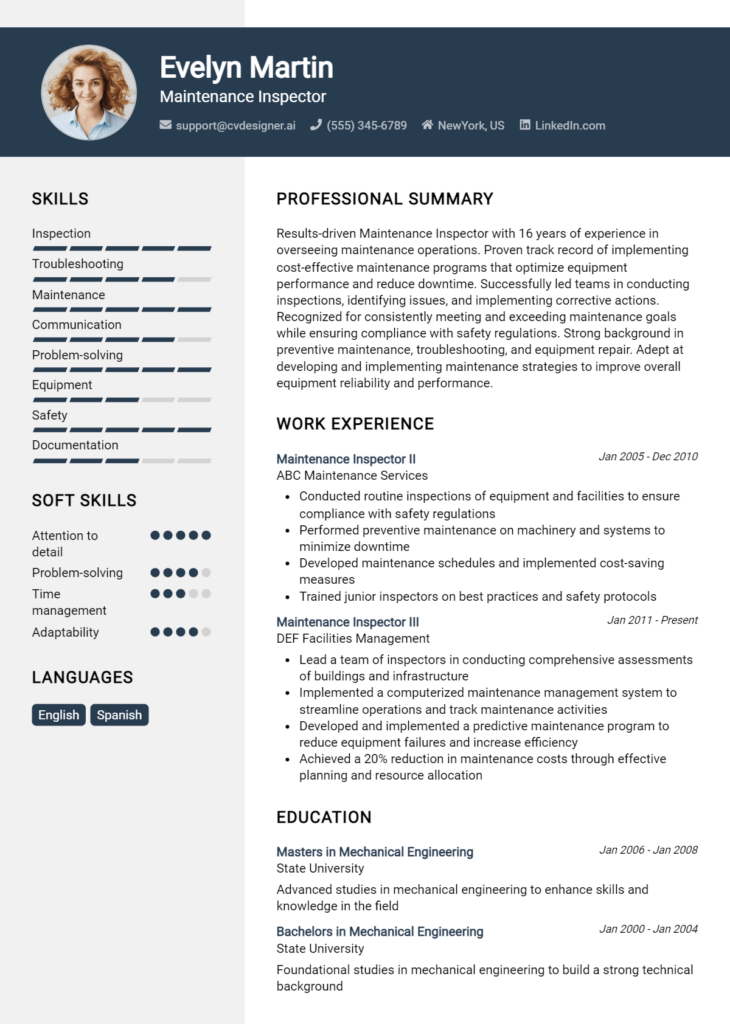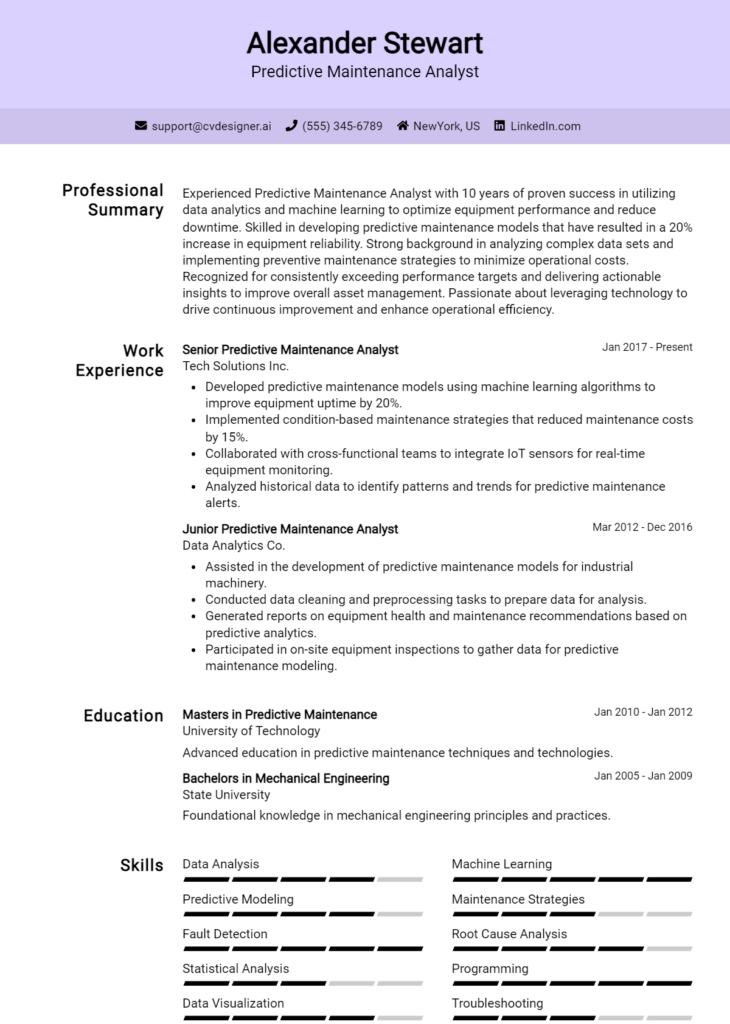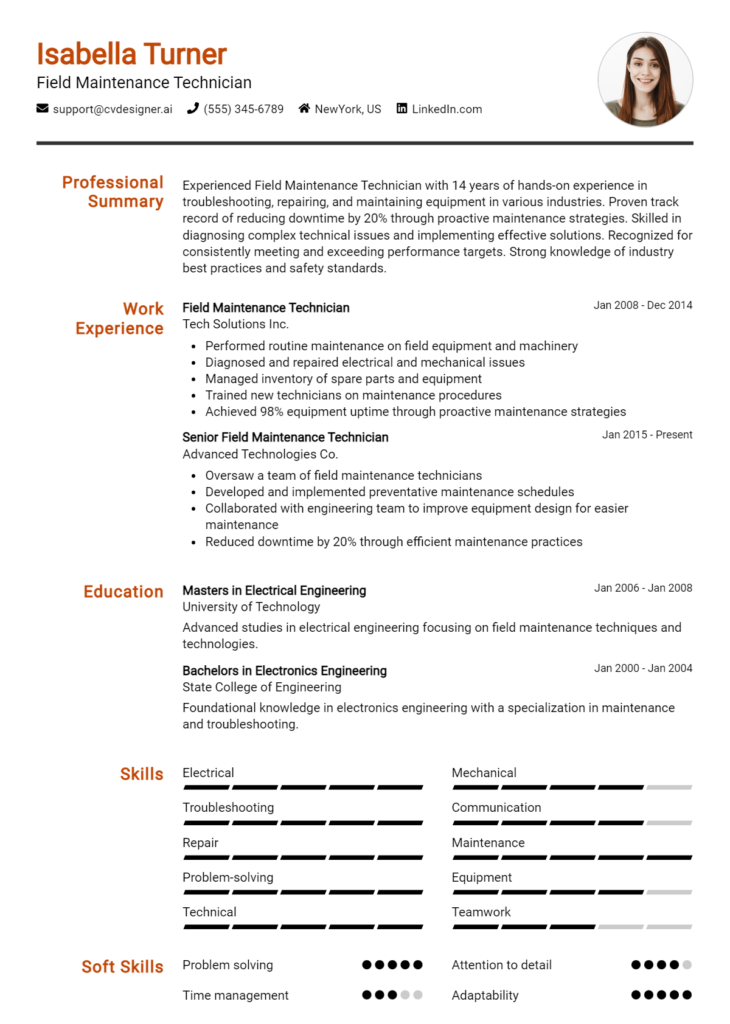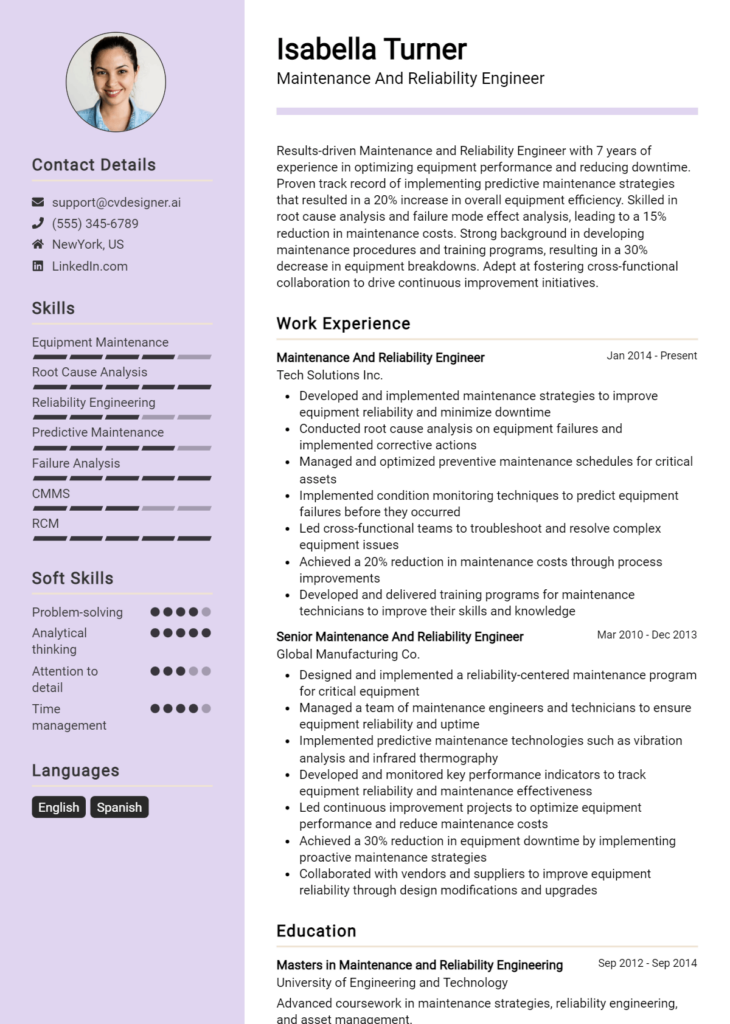Condition Monitoring Technician Core Responsibilities
A Condition Monitoring Technician plays a vital role in ensuring equipment reliability through the analysis of machinery performance metrics. Key responsibilities include conducting regular inspections, analyzing vibration and acoustic data, and collaborating with engineering and maintenance teams to address potential issues. Essential skills encompass technical proficiency in diagnostic tools, operational understanding of machinery, and strong problem-solving capabilities. These skills contribute significantly to organizational goals by minimizing downtime and optimizing performance. A well-crafted resume can effectively highlight these qualifications, showcasing the technician's ability to bridge various departments.
Common Responsibilities Listed on Condition Monitoring Technician Resume
- Conduct routine condition monitoring inspections and assessments.
- Analyze data from vibration, thermal, and acoustic sensors.
- Collaborate with maintenance teams to develop preventive maintenance plans.
- Generate detailed reports on equipment conditions and trends.
- Identify potential equipment failures and recommend corrective actions.
- Utilize diagnostic tools to troubleshoot machinery issues.
- Participate in root cause analysis for equipment failures.
- Maintain accurate records of monitoring activities and findings.
- Train staff on condition monitoring techniques and best practices.
- Stay updated with technology advancements in condition monitoring.
- Support cross-functional teams in optimizing equipment performance.
High-Level Resume Tips for Condition Monitoring Technician Professionals
In today's competitive job market, a well-crafted resume can be the difference between landing an interview and being overlooked. For Condition Monitoring Technician professionals, this document serves as the first impression to potential employers, making it essential to effectively reflect both skills and achievements. Your resume should not only outline your technical expertise and experience but also demonstrate your ability to contribute to the efficiency and reliability of systems in various industries. This guide will provide practical and actionable resume tips specifically tailored for Condition Monitoring Technician professionals to help you stand out from the crowd.
Top Resume Tips for Condition Monitoring Technician Professionals
- Tailor your resume to the specific job description by highlighting relevant skills and experiences that match the employer's needs.
- Showcase your hands-on experience with condition monitoring tools and techniques, including any specialized equipment you are proficient in.
- Quantify your achievements with concrete data, such as percentage improvements in machinery uptime or reductions in maintenance costs.
- Highlight industry-specific certifications, such as ISO standards or vibration analysis certifications, to demonstrate your expertise.
- Include a technical skills section that lists relevant software and tools you are familiar with, such as CMMS or predictive maintenance software.
- Emphasize your problem-solving abilities by detailing specific challenges you faced and how you addressed them successfully.
- Incorporate keywords from the job posting to pass through Applicant Tracking Systems (ATS) and increase your chances of being noticed.
- Use a clean and professional format that is easy to read, ensuring that key information stands out to the hiring manager.
- Keep your resume concise, ideally one page, while ensuring you include all necessary information that demonstrates your qualifications.
By implementing these tips, you can significantly increase your chances of landing a job in the Condition Monitoring Technician field. A focused and well-structured resume not only highlights your qualifications but also showcases your commitment to the role, making you a more attractive candidate to potential employers.
Why Resume Headlines & Titles are Important for Condition Monitoring Technician
The role of a Condition Monitoring Technician is vital in ensuring the reliability and efficiency of machinery and equipment through proactive maintenance strategies. A well-crafted resume headline or title is essential, as it serves as the first impression for hiring managers. A powerful headline can succinctly encapsulate a candidate’s key qualifications, making it easier for employers to quickly assess a candidate's fit for the position. A strong resume title should be concise, relevant, and directly related to the job being applied for, effectively grabbing attention and encouraging further reading.
Best Practices for Crafting Resume Headlines for Condition Monitoring Technician
- Keep it concise: Aim for a headline that is no longer than 10 words.
- Be specific: Use terminology relevant to condition monitoring to demonstrate expertise.
- Highlight key skills: Incorporate critical skills or certifications related to the position.
- Use action words: Begin with strong verbs to convey an active approach to your work.
- Tailor to the job: Customize the headline for each application to align with the job description.
- Showcase achievements: If possible, include quantifiable results or accomplishments.
- Avoid clichés: Steer clear of overused phrases that lack impact.
- Maintain professionalism: Ensure the tone aligns with the expectations of the industry.
Example Resume Headlines for Condition Monitoring Technician
Strong Resume Headlines
Experienced Condition Monitoring Technician with 5+ Years in Predictive Maintenance
Certified Vibration Analyst Specializing in Machinery Reliability Solutions
Proactive Condition Monitoring Expert with Proven Track Record of Reducing Downtime
Skilled Technician in Acoustic Emission Testing and Data Analysis
Weak Resume Headlines
Technician Looking for a Job
Condition Monitoring Professional
Strong headlines are effective because they clearly communicate the candidate’s specific expertise and accomplishments, making them stand out in a competitive job market. They provide clear, actionable information that aligns with the needs of potential employers. In contrast, weak headlines fail to impress due to their vagueness and lack of distinctive qualities, which can make a candidate appear less qualified or memorable. By avoiding generic phrases, candidates can enhance their chances of being noticed by hiring managers.
Writing an Exceptional Condition Monitoring Technician Resume Summary
Crafting an exceptional resume summary is crucial for a Condition Monitoring Technician, as it serves as the first impression a hiring manager will have of a candidate's qualifications. A strong summary quickly captures attention by highlighting key skills, relevant experience, and significant accomplishments that align with the job role. It should be concise yet impactful, providing a snapshot of the candidate's professional identity and demonstrating their value to the potential employer. Tailoring the summary to the specific job being applied for ensures that it resonates with the hiring manager and increases the chances of securing an interview.
Best Practices for Writing a Condition Monitoring Technician Resume Summary
- Quantify Achievements: Use numbers and statistics to demonstrate the impact of your work.
- Focus on Relevant Skills: Highlight specific skills that are directly applicable to condition monitoring.
- Tailor for the Job Description: Customize your summary to align with the responsibilities and requirements listed in the job posting.
- Be Concise: Keep the summary to 3-5 sentences to maintain clarity and focus.
- Use Action Words: Start sentences with strong action verbs to convey your experiences effectively.
- Showcase Certifications: Mention relevant certifications or training that enhance your qualifications.
- Highlight Problem-Solving Abilities: Emphasize your capacity to identify and address equipment issues proactively.
- Demonstrate Industry Knowledge: Include any specific knowledge related to the industry you are applying to, such as familiarity with certain machinery or technologies.
Example Condition Monitoring Technician Resume Summaries
Strong Resume Summaries
Detail-oriented Condition Monitoring Technician with over 5 years of experience in predictive maintenance and vibration analysis. Successfully reduced machine downtime by 30% through effective monitoring and timely interventions, resulting in cost savings of $50,000 annually.
Dedicated technician with extensive expertise in condition monitoring techniques, including thermography and ultrasound. Achieved a 25% reduction in maintenance costs through proactive assessments and successful implementation of predictive maintenance strategies.
Results-driven Condition Monitoring Technician skilled in data analysis and equipment diagnostics, leading to a 40% decrease in unexpected equipment failures. Proficient in utilizing software tools like CMMS and SAP for tracking maintenance activities.
Weak Resume Summaries
Experienced technician looking for a job in condition monitoring. I have worked on various machines and can do maintenance tasks.
Condition Monitoring Technician with some experience. I am familiar with tools and techniques used in the field and hope to contribute to a team.
The examples above illustrate the key differences between strong and weak resume summaries. Strong summaries effectively quantify achievements and highlight specific skills that directly relate to the role of a Condition Monitoring Technician, making them impactful and relevant. In contrast, weak summaries are vague, lack measurable outcomes, and fail to convey the candidate's qualifications effectively, rendering them less appealing to hiring managers.
Work Experience Section for Condition Monitoring Technician Resume
The work experience section of a Condition Monitoring Technician resume is crucial in demonstrating the candidate's technical skills, leadership capabilities, and commitment to delivering high-quality results. This section serves as a testament to the technician's practical knowledge in condition monitoring techniques, predictive maintenance, and data analysis, showcasing their ability to manage teams effectively and contribute to operational excellence. By quantifying achievements and aligning experiences with industry standards, candidates can distinguish themselves in a competitive job market, highlighting their value to potential employers.
Best Practices for Condition Monitoring Technician Work Experience
- Focus on technical expertise by detailing specific monitoring tools and methodologies used.
- Quantify achievements using metrics such as reduced downtime, cost savings, or increased efficiency.
- Highlight instances of teamwork and collaboration with engineering and maintenance teams.
- Tailor experiences to align with the specific requirements of the job description.
- Include certifications or training relevant to condition monitoring techniques and technologies.
- Use action verbs to convey a proactive approach to problem-solving and project management.
- Provide context for your contributions to illustrate the impact on the organization.
- Maintain clarity and precision in descriptions to avoid ambiguity and enhance readability.
Example Work Experiences for Condition Monitoring Technician
Strong Experiences
- Led a team in implementing a new vibration analysis program, resulting in a 25% reduction in machine failures over 12 months.
- Conducted thorough data analysis for predictive maintenance, achieving a 30% decrease in maintenance costs by optimizing service schedules.
- Collaborated with cross-functional teams to develop a condition monitoring strategy that improved overall equipment effectiveness (OEE) by 15%.
- Trained and mentored junior technicians, enhancing team performance and reducing onboarding time by 40%.
Weak Experiences
- Assisted in monitoring equipment performance.
- Worked on various maintenance projects.
- Helped the team with condition monitoring tasks.
- Participated in training sessions.
The examples labeled as strong demonstrate clear, quantifiable outcomes and show how the candidate made a significant impact in their roles. They highlight leadership, collaboration, and specific technical skills that are valuable in the field of condition monitoring. In contrast, the weak experiences are vague and lack quantifiable results, failing to convey the candidate's contributions or the skills utilized, which diminishes their overall effectiveness in a resume.
Education and Certifications Section for Condition Monitoring Technician Resume
The education and certifications section of a Condition Monitoring Technician resume is crucial as it serves as a testament to the candidate's academic background, industry-relevant certifications, and commitment to continuous learning. This section allows potential employers to gauge the candidate's qualifications and readiness for the role by providing tangible evidence of their knowledge and skills. By including relevant coursework, specialized training, and recognized certifications, candidates can significantly enhance their credibility and demonstrate alignment with the specific requirements of the job, making them more appealing to hiring managers.
Best Practices for Condition Monitoring Technician Education and Certifications
- Focus on relevant degrees, such as an Associate's or Bachelor's in Engineering, Mechanical Technology, or a related field.
- Highlight industry-recognized certifications, such as Certified Reliability Engineer (CRE) or Condition Monitoring Technician Certification.
- Include specialized training programs that directly relate to condition monitoring tools and technologies.
- Detail relevant coursework that covers topics such as vibration analysis, thermography, and predictive maintenance.
- Ensure that certifications are current and reflect the latest industry standards and practices.
- Use a clear and consistent format that allows for easy scanning of information by hiring managers.
- Consider including professional development courses or workshops to showcase ongoing education.
- List any memberships in professional organizations related to maintenance and reliability engineering.
Example Education and Certifications for Condition Monitoring Technician
Strong Examples
- Bachelor of Science in Mechanical Engineering, University of Technology, 2021
- Certified Condition Monitoring Technician (CCMT), International Society of Automation, 2022
- Vibration Analysis Level I Certification, Vibration Institute, 2023
- Coursework in Predictive Maintenance and Reliability Engineering, University of Technology
Weak Examples
- Bachelor of Arts in English Literature, University of Arts, 2010
- Certification in Basic Computer Skills, 2015
- High School Diploma, 2005
- Outdated certification in General Maintenance, obtained in 2010
The strong examples are considered effective because they directly relate to the skills and knowledge required for a Condition Monitoring Technician. They showcase relevant degrees, up-to-date certifications, and specific coursework that align with the job's demands. In contrast, the weak examples highlight irrelevant educational qualifications and outdated certifications that do not contribute to the candidate's suitability for the role, thus potentially diminishing their chances of being selected for an interview.
Stand Out with a Winning Condition Monitoring Technician Cover Letter
Dear [Hiring Manager's Name],
I am writing to express my interest in the Condition Monitoring Technician position at [Company Name], as advertised on [where you found the job listing]. With a solid foundation in mechanical systems and a robust background in condition monitoring techniques, I am excited about the opportunity to contribute to your team and support the maintenance of your equipment. My hands-on experience with vibration analysis, infrared thermography, and ultrasonic testing, combined with my commitment to safety and efficiency, positions me as a strong candidate for this role.
In my previous position at [Previous Company Name], I successfully implemented a predictive maintenance program that reduced equipment downtime by over 20%. By utilizing advanced diagnostic tools and conducting thorough inspections, I was able to identify potential issues before they escalated, saving the company both time and money. My ability to analyze data and generate detailed reports has also enhanced the decision-making process for maintenance schedules and asset management. I pride myself on being detail-oriented and proactive in my approach to ensuring optimal equipment performance.
I am particularly drawn to [Company Name] because of its commitment to innovation and excellence in the industry. I believe that my technical skills, coupled with my passion for continuous improvement, align well with your company’s objectives. I am eager to bring my expertise in condition monitoring and my strong problem-solving abilities to your team, ensuring that your operations run smoothly and efficiently.
Thank you for considering my application. I look forward to the opportunity to discuss how my skills and experiences can contribute to the continued success of [Company Name]. Please feel free to contact me at your earliest convenience to schedule a conversation.
Sincerely,
[Your Name]
[Your Phone Number]
[Your Email Address]
Common Mistakes to Avoid in a Condition Monitoring Technician Resume
When crafting a resume for the role of a Condition Monitoring Technician, it's essential to present your skills and experiences effectively to capture the attention of hiring managers. However, many candidates make common mistakes that can diminish their chances of landing an interview. Avoiding these pitfalls can significantly enhance the quality of your resume and demonstrate your professionalism and suitability for the role.
Neglecting Relevant Certifications: Failing to highlight relevant certifications such as vibration analysis or thermography can lead to missed opportunities, as these qualifications are often crucial in condition monitoring roles.
Using Jargon or Technical Language Excessively: While it's important to showcase your technical knowledge, overloading your resume with jargon can confuse readers. Aim for clarity by balancing technical terms with plain language.
Lack of Quantifiable Achievements: Simply stating job responsibilities without quantifying your accomplishments can make your resume less impactful. Use metrics to showcase improvements, such as reduced downtime or increased efficiency.
Ignoring Keywords from the Job Description: Many companies use Applicant Tracking Systems (ATS) that filter resumes based on keywords. Failing to incorporate specific terms from the job description can lead to your resume being overlooked.
Poor Formatting and Organization: A cluttered or unorganized resume can detract from your qualifications. Use clear headings, bullet points, and consistent fonts to improve readability and ensure your information is easily accessible.
Inconsistent Work History: Presenting a disjointed work history without clear connections can raise red flags for employers. Ensure your experiences flow logically and clearly demonstrate your career progression.
Overlooking Soft Skills: While technical expertise is vital, overlooking the importance of soft skills like teamwork, communication, and problem-solving can weaken your resume. Highlight these traits to show your ability to work well in a team environment.
Not Tailoring the Resume for Each Application: Sending out a generic resume for every job can be detrimental. Tailoring your resume to match the specific needs and expectations of each employer shows genuine interest and attention to detail.
Conclusion
As a Condition Monitoring Technician, your role is pivotal in ensuring machinery operates efficiently and reliably. The article outlined several key responsibilities, including conducting regular inspections, utilizing advanced diagnostic tools, and analyzing data to predict equipment failures. Understanding vibration analysis, thermography, and oil analysis techniques are also critical for effective monitoring and maintenance.
Moreover, the importance of effective communication with maintenance teams and management was emphasized, as it ensures that insights from condition monitoring can be translated into actionable maintenance strategies. Staying updated with the latest technologies and methodologies in condition monitoring is essential for career advancement in this field.
In conclusion, it's crucial to present your skills and experiences effectively in your resume to stand out in this competitive job market. We encourage you to review your Condition Monitoring Technician resume today. Enhance your chances of landing your dream job by utilizing the available resources such as resume templates, try our resume builder, explore resume examples, and craft a compelling application with our cover letter templates. Take action now to elevate your career!

